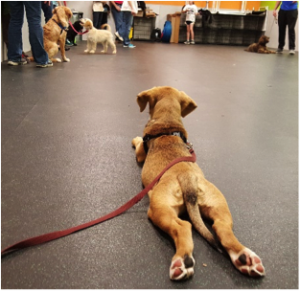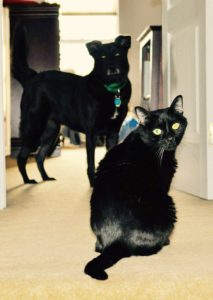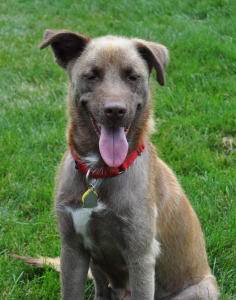
Owners: You should train your dog. Maybe you think training is a waste of money or maybe just a waste of time. Or you grew up with dogs and know with enough repetition your dog will ‘get’ the important stuff eventually. Perhaps you think if people can rewire a house using YouTube tutorials, you can do the same to train your dog. Maybe your dog isn’t a puppy anymore and you know the familiar adage about old dogs and new tricks.
Well, let me share 5 reasons why you should train your dog.
Reason #1 to train your dog: Socialization
This is a common one but is so important that it’s worth mentioning again. In most cases, the best way to avoid having a skittish or aggressive dog is to well socialize them with other people and dogs. Group classes are a great way to socialize and train your dog.
No matter how many walks you take, nothing is as effective at socializing a young pup as spending an hour a week in a room with a dozen strange humans and 5 other dogs. You never know what you’re going to get with dogs on the street or at a dog park but in class you know your dog is having an opportunity to learn how to interact with others in a safe, supervised environment that will leave your dog feeling confident and interested in new things.
Reason #2 to train your dog: The Internet Is Not Enough
There are a LOT of experts on the internet with advice on how to train your dog… a LOT. In fact, there are so many that it can be overwhelming. Many have respectable backgrounds, but all their advice doesn’t always line up; more often then not they actually contradict!
backgrounds, but all their advice doesn’t always line up; more often then not they actually contradict!
To crate or not to crate? For how long? What kind of collar? What do you teach first? How? Is dominance and submission a reliable philosophy or is it an outdated fallacy?
While some online and book sources will admit that not all dogs fit every rule, they don’t empower you with the tools to identify those exceptions and grey areas. Trainers certainly have their own philosophies and a good trainer will get to know you and your dog. Then they will be able to identify when is time to try alternative techniques and methods that best fit your dog.
Reason #3 to train your dog: Old Dogs LIKE Learning New Tricks
Just like humans, a puppy’s growing brain is more elastic and learns things faster than an older dog; however, that doesn’t mean an adult dog can’t learn something new. Most often, the benefit of class for older dogs is not even about a specific new trick at all; it’s the process.
Also like humans, dogs get bored. If all they do is go on walks or play a 5 minute round of fetch in the backyard a new challenge can be fun and exciting for your dog. A lethargic or grumpy dog can become alert and energized while trying to work through new commands. The attention and reward the effort brings is incredibly valuable to a dog.
If you’ve adopted an adult dog who already knows the basics and you are trying to build a relationship, going to a tricks or agility class is a great place to start! Your dog may not come out jumping through hoops like a circus dog, but the process of working towards a goal together will help create that special bond that is a little easier to develop with a puppy.
Reason #4 to train your dog: It Is Cost Effective
 The value of a well trained dog can’t be overstated. How many stories have you heard of dogs tearing through couch cushions, digging up rhododendrons or ruining carpets?
The value of a well trained dog can’t be overstated. How many stories have you heard of dogs tearing through couch cushions, digging up rhododendrons or ruining carpets?
The one to two hundred dollars you’ll spend on decent training can save you literally thousands in home repairs or furniture replacement.
Even the most well trained dog can act out. A good trainer will help you be prepared to identify the causes of common behaviors. And they will provide you the tools to address the issue.
Maybe your dog chews when he’s bored, digs when anxious or is marking as part of an adolescent phase. A dog trainer is a resource that will guide you to activities, products and solutions that will keep you from going crazy and keep your furniture intact. A worthwhile investment!
**Bonus Points** Well behaved dogs are often welcome in friends and families homes. This means not needing to hire a sitter if you travel for the holidays.
**Double Bonus Points** Have you ever had difficulty looking for an affordable apartment that would accept your four legged friend? Some landlords will make exceptions if you introduce them to your well behaved dog!
Reason #5 to train your dog: It’s Not Just About The Dog
It’s about you.
If you know you want a well trained pet you may be tempted by ‘boot camp’ training options; send your dog away for 3 to 10 days and they come back knowing all the commands and completely compliant.
For some that may be the best option. However, the dog owner doesn’t have the opportunity to learn nearly as much that way. Going to class gives dog owners the opportunity to observe their dog compared to others, have discussion, and ask questions. You have the opportunity to watch how your dog responds differently to commands from the trainer. This gives you the chance to experiment with varying tone and body language to most effectively communicate with your dog. You will see what other families are struggling with. This can help you gauge if a particular challenge is a common phase or a problem unique to you which requires extra attention.
If you have what you consider a tricky situation (kids at home, work full time, your new pet has complicated history) a trainer will be ready with suggestions for how to handle things specifically tailored for you and your family.
An experienced and certified trainer can guide you through what is important. They give you the tools and building blocks of responsible dog ownership that clears away the stress of trying to figure out the right things to do.
There is also the bond that is created by going through the effort alongside your pet. Class feels like a series of games and challenges for your dog. You playing alongside them helps to create an ever lasting bond and increase your dog’s innate trust in you.
All in all there is a lot that happens on many levels in an hour class; with a good trainer the humans will leave just as mentally exhausted as the dogs!
The truth is that training is not the magic bullet that reliably turns all dogs in to rock solid pups as well behaved as a seeing eye dog. However, the process has as much value as the results.
After a series of classes my dog still doesn’t quite understand fetch. She isn’t always so keen on ‘drop it’. But I have no concern about bringing her to visit a friends’ house or sitting on a busy patio at a restaurant. My boss welcomes her to the office. My landlord accepted her at home. I can leave her to entertain herself with out worrying about returning to the trash strewn about. We go on off leash hikes and play soccer on the town fields. At the end of the day, she snuggles at my side before putting herself to bed.
Dogs can be great companions but they can also be incredibly frustrating. Making the effort to train your dog can help grow the kind of positive and rewarding relationship that make dogs so valuable in our lives.
Interested in private training lessons more your speed?
The author of this post is Pepper’s Paws client Courtney Beard. Courtney and her dog Charlotte completed private puppy training lessons, AKC S.T.A.R. Puppy class, Level 1 Manners, Level 2 Manners, Dog Tricks 101, and Out and About Obedience class with us. Courtney gave me this post as a thank you gift for helping her have the dog of her dreams. She would still be training with us if she had not moved out of the area. Courtney’s dedication to her dog is a pleasure to witness! Thank you Courtney for trusting us to teach you and your dog!
Pepper’s Paws, LLC provides in home dog training for basic manners, behavior problems, and fear aggression in Rehoboth Beach, DE. We also offer Zoom dog training lessons for people who are not in our private lessons service area.
Head trainer Deb Murray, is Certified Canine Behavior Consultant (CBCC-KA) and Certified Professional Dog Training (CPDT-KA) by the Certification Council of Professional Dog Trainers, a Fear Free Certified Trainer, an AKC Evaluator, and a Distinguished Graduate and Mentor Trainer for the Catch Canine Academy.
 them mental stimulation (think tired brain)! Toys come in all shapes, sizes, and challenge levels. Most puzzle toys reward the dog with food for solving the puzzle. That makes puzzle toys a great way to feed your dog a meal too! Puzzle toys are great for cold or hot days when a long walk isn’t safe. They add some run to a boring rainy day inside. They can also provide lots of challenge for very little owner work too!
them mental stimulation (think tired brain)! Toys come in all shapes, sizes, and challenge levels. Most puzzle toys reward the dog with food for solving the puzzle. That makes puzzle toys a great way to feed your dog a meal too! Puzzle toys are great for cold or hot days when a long walk isn’t safe. They add some run to a boring rainy day inside. They can also provide lots of challenge for very little owner work too!













